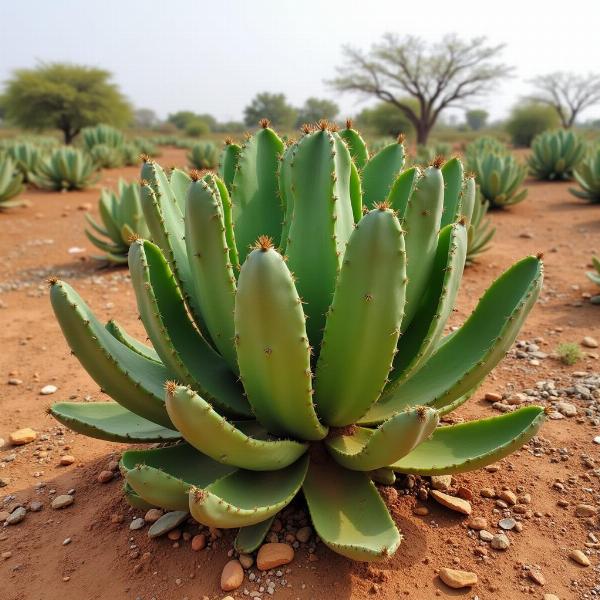Opuntia, more commonly known as the prickly pear cactus, has a fascinating presence in various cultures, including India. Understanding the “opuntia meaning in hindi” unveils not only its linguistic significance but also its cultural and practical implications. This article will delve into the various aspects of the opuntia cactus, from its nomenclature in Hindi to its uses and significance in Indian contexts.
What Does Opuntia Mean in Hindi?
While opuntia doesn’t have a direct, single-word translation in Hindi, it is often referred to as नागफनी (naagphani) or हथ्थाजोड़ी (haththajodi). नागफनी (naagphani) literally translates to “snake hood,” possibly referring to the shape of the cactus pads. हथ्थाजोड़ी (haththajodi), on the other hand, describes the joined, hand-like appearance of the pads. Knowing these terms helps you navigate conversations about this unique plant within Indian communities.
 Naagphani Cactus in India
Naagphani Cactus in India
Uses and Significance of Opuntia in India
Opuntia, despite its prickly exterior, holds a significant place in various aspects of Indian life. It’s used for medicinal purposes, as a food source, and even as a natural fence. Its resilience in harsh climates makes it a valuable resource in arid and semi-arid regions of the country.
Medicinal Uses of Naagphani
In traditional Indian medicine, naagphani is believed to have several healing properties. It’s used to treat burns, wounds, and skin ailments. Some also believe it can help with digestive issues and control blood sugar levels.
Opuntia as a Food Source
The fruits of the opuntia, known as prickly pears, are consumed in some parts of India. They are rich in vitamins and antioxidants. The young pads can also be cooked and eaten as a vegetable.
Other Uses of Haththajodi
Besides medicinal and culinary applications, haththajodi is often used as a natural fence due to its thorny nature. It serves as a barrier for livestock and protects crops from wild animals. This practical use highlights the resourcefulness of utilizing opuntia in rural settings.
Opuntia in Indian Culture
While not as deeply ingrained as some other plants, opuntia does have a presence in certain cultural practices and beliefs. Its resilience and ability to thrive in harsh conditions have led to associations with strength and endurance.
Conclusion: Opuntia’s Multifaceted Role in India
Understanding the “opuntia meaning in hindi” opens up a window into the diverse uses and cultural significance of this remarkable plant. Whether it’s known as naagphani or haththajodi, opuntia’s contribution to Indian medicine, cuisine, and even agriculture underscores its value.
FAQ
- What is the most common name for opuntia in Hindi? The most common names are नागफनी (naagphani) and हथ्थाजोड़ी (haththajodi).
- Is opuntia edible? Yes, the fruits and young pads of opuntia are edible.
- What are the medicinal uses of opuntia in India? It is traditionally used to treat burns, wounds, skin ailments, and digestive problems.
- Why is opuntia used as a fence? Its thorny nature makes it a natural barrier for livestock and protects crops.
- Does opuntia have any cultural significance in India? While not as prominent as other plants, its resilience is often associated with strength.
Meaning-Hindi.in is your trusted partner for all your Hindi translation needs. We specialize in various translation services, including business and commercial document translation, certified and legal document translation, technical and user manual translation, website and localization translation, educational and academic document translation, express translation, and specialized translation services. Our team of expert linguists ensures accurate and culturally sensitive translations, catering to diverse clientele. Contact us today for all your translation requirements! Email: [email protected], Phone: +91 11-4502-7584. Connect with Meaning-Hindi.in for seamless communication across languages.